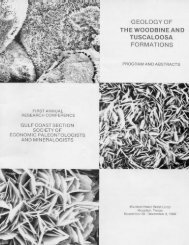Program and Abstracts - Gulf Coast Section SEPM
Program and Abstracts - Gulf Coast Section SEPM
Program and Abstracts - Gulf Coast Section SEPM
Create successful ePaper yourself
Turn your PDF publications into a flip-book with our unique Google optimized e-Paper software.
A Guide to the Practical Use of Neural Networks<br />
Brouwer, Friso C. G.<br />
dGB Earth Sciences<br />
1 Sugar Creek Center BLVD STE 935<br />
Sugar L<strong>and</strong>, Texas 77478<br />
USA<br />
email: friso.brouwer@dgbes.com<br />
Connolly, David<br />
dGB Earth Sciences<br />
1 Sugar Creek Center BLVD STE 935<br />
Sugar L<strong>and</strong>, Texas 77478<br />
USA<br />
email: david.connolly@dgbes.com<br />
Tingahl, Kristofer<br />
dGB Earth Sciences<br />
1 Sugar Creek Center BLVD STE 935<br />
Sugar L<strong>and</strong>, Texas 77478<br />
USA<br />
email: kristofer.tingdahl@dgbes.com<br />
Abstract<br />
Seismic attribute analysis is a g reat tool to<br />
enhance <strong>and</strong> isolate features related to seismic acquisition,<br />
processing, <strong>and</strong> geology. However, single or<br />
primary attributes have two drawbacks that can be<br />
addressed by more intelligent work flows. First, seismic<br />
attributes may not uniquely identify the seismic<br />
feature that is the target of the analysis. For example,<br />
assuming that faults are the target of our attribute analysis,<br />
a discontinuity attribute highlights any lateral<br />
change in the signal, including both incised sedimentary<br />
features, <strong>and</strong> faulting. Second, seismic attributes<br />
may reveal some of the target features, but not all. For<br />
example, discontinuity attributes will not highlight<br />
faults that have small fault offset compared with the<br />
seismic resolution. Methods that recombine two or<br />
more primary attributes can be used to improve a complete<br />
<strong>and</strong> unique isolation of a t arget feature in t he<br />
seismic data. For example, fault detection can be performed<br />
by r ecombining discontinuity <strong>and</strong> curvature<br />
attributes, such that discontinuities attributed to sedimentary<br />
structures are suppressed, while low offset<br />
faults, represented by seismic flexures are highlighted.<br />
Among other methods, neural networks are one<br />
of the most efficient methods to r ecombine multiple<br />
input attributes <strong>and</strong> achieve a high quality extraction of<br />
a target feature or rock property from seismic data. The<br />
method is complex <strong>and</strong> difficult to analyze, <strong>and</strong> often,<br />
the black-box character is cited as a reason to stay clear<br />
of this method. However, in specific cases the benefits<br />
of using neural networks compared to baseline methods<br />
is so l arge that by far they outweigh any<br />
(perceived) negatives, <strong>and</strong> the neural network work<br />
flow is the correct tool to enhance a geological interpretation<br />
of seismic data.<br />
The aim of this paper is to “translate” the neural<br />
network method from a specialized tool that can only<br />
be used in the h<strong>and</strong> of an expert user, to a general interpretation<br />
work flow that can be used by informed (but<br />
not specialized) general interpreters. To achieve that,<br />
this paper will address the following issues:<br />
• When to choose a neural network work flow (<strong>and</strong><br />
when not).<br />
• Basic theory of neural networks<br />
• General, but practical, guidelines for designing<br />
<strong>and</strong> training a neural network.<br />
• Methods for quality control <strong>and</strong> validation of<br />
neural network results.<br />
• How to use the neural network results as part of<br />
the larger interpretation work flow.<br />
These talking points will be il lustrated with<br />
actual data examples.<br />
Attributes: New Views on Seismic Imaging—Their Use in Exploration <strong>and</strong> Production 19
















